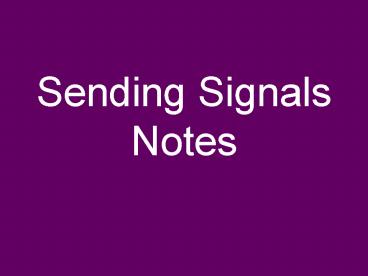Sending Signals Notes - PowerPoint PPT Presentation
1 / 21
Title:
Sending Signals Notes
Description:
Title: Neuron and Action Potential Notes Author: Andrea DeMent Last modified by: Tablet PC Created Date: 1/4/2005 3:45:59 AM Document presentation format – PowerPoint PPT presentation
Number of Views:86
Avg rating:3.0/5.0
Title: Sending Signals Notes
1
Sending Signals Notes
2
Structure of Single Neuron
3
Neurons
- http//facweb.gsw.edu/gfisk/anim/neuronparts.swf
4
(No Transcript)
5
(No Transcript)
6
(No Transcript)
7
3 types of Neurons Sensory Neurons neurons
that carry incoming information from the sense to
the CNS Interneurons CNS neurons that
internally communicate and intervene between the
sensory inputs and motor outputs Motor Neurons
Carry outgoing information from the CNS to muscle
and glands
8
Sensor Receptor
Sensory Input
Integration
Effector
Motor Output
9
Neuron SignalsACTION POTENTIAL
10
(No Transcript)
11
(No Transcript)
12
(No Transcript)
13
- The point of contact at which impulses are passed
from one cell to another are known as THE
SYNAPTIC CLEFT OR SYNAPSE. - Neurons that transmit impulses to other neurons
DO NOT actually touch one another. The Small Gap
or Space between the axon of one neuron and the
dendrites of the next neuron is called the
Synapse. - One importance of the presence of Synapses is
that they ensure one-way transmission of impulses
in a living person. - The Axon Terminals at a Synapse contain tiny
vesicles, or sacs. These are known as
NEUROTRANSMITTERS.
14
(No Transcript)
15
- NEUROTRANSMITTER is a chemical substance that is
used by one neuron to signal another. The
impulse is changed from an Electrical Impulse to
a Chemical Impulse (Electrochemical Impulses).
16
(No Transcript)
17
Other facts
- After the neurotransmitter relays it message it
is rapidly REMOVED or DESTROYED, thus halting its
effect. - Neurotransmitters may be broken down by ENZYMES,
taken up again by the axon terminal and recycled,
or they may simply diffuse away. - NERVE GAS prevents enzymes from breaking down
neurotransmitters, as a result muscles in the
respiratory and nervous system becomes paralyzed.
18
The End
- The End The End The End The End The End The End
The End The End The End The End The End The End
The End The End The End The End The End The End
The End The End The End The End The End The End
The End The End The End The End The End The End
The End The End The End The End The End The End
The End The End The End The End The E
19
- When an impulse reaches the Axon Terminal, dozen
of vesicles fuse with the cell membrane and
discharge the Neurotransmitter into the Synaptic
Cleft (GAP). - The molecules of the neurotransmitter diffuse
across the gap and attach themselves to SPECIAL
RECEPTORS on the membrane of the neuron receiving
the impulse. - When the neurotransmitter becomes attached to the
cell membrane of the adjacent nerve cell, it
changes the permeability of that membrane. - As a result, Na ions diffuse through the
membrane into the cell. - If enough neurotransmitter is released by the
axon terminal, so many Na ions diffuse into the
neuron that the neuron becomes DEPOLARIZED.
20
- DEPOLARIZED Inside the membrane becomes more
positive than outside. - This causes a THRESHOLD to be REACHED and an
impulse (ACTION POTENTIAL) begins in the second
cell. - After the neurotransmitter relays it message it
is rapidly REMOVED or DESTROYED, thus halting its
effect. - The molecules of the neurotransmitter may be
broken down by ENZYMES, taken up again by the
axon terminal and recycled, or they may simply
diffuse away. - NERVE GAS prevents enzymes from breaking down
neurotransmitters, as a result muscles in the
respiratory and nervous system becomes paralyzed.
21
Action Potentials
- http//facweb.gsw.edu/gfisk/anim/actionpotential.
swf































